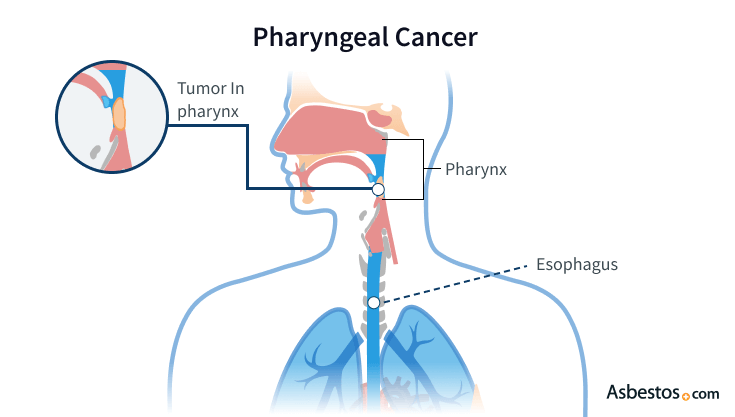Pharyngeal Cancer
Pharyngeal cancer is primarily associated with heavy use of tobacco and alcohol. Studies show the cancer is more common among asbestos workers than the general population. Treatment is effective, especially when the cancer is caught early.

What is Pharyngeal Cancer?
Pharyngeal cancer is a disease that involves the abnormal development and spread of cells that destroy healthy cells in the pharynx. It’s often called throat cancer because the pharynx is a hollow tube in your throat that starts behind your nose and ends at your windpipe or trachea.

Pharyngeal cancer statistics are grouped with oral cavity cancer. About 54,000 new cases cases of pharyngeal and oral cavity cancer were diagnosed in the U.S. in 2022.
The prognosis is quite good compared to most other cancers, especially when compared to asbestos-related cancers such as mesothelioma and lung cancer. Approximately 65% of all pharyngeal cancer patients live longer than five years and 44% survive more than 10 years.
Treatment for this cancer involves surgery, chemotherapy and radiation therapy for those diagnosed in stage 1 or 2. Chemotherapy, radiation therapy and immunotherapy are advised for people diagnosed in stage 3 or 4. In a 2021 clinical research study, patients who had endoscopic treatment for superficial pharyngeal cancer had a 5-year survival rate of 84.1%.
Symptoms
The most common symptoms of pharyngeal cancer include:
- Painless lump in the upper neck
- Swelling of the neck
- Nasal congestion
- Nosebleeds
- Facial pain
- Headaches
- Ringing in the ears (tinnitus)
- Changes in hearing
Knowing what symptoms to watch for can help increase chances of early diagnosis, which can increase survival. Nearly 30% of patients are diagnosed in stage 1, and about 84% of that group lives longer than five years.

You shouldn’t have to choose between getting care and paying for it. Get the financial support you deserve.
See My OptionsRisk Factors
A risk factor is anything that increases your chance of developing a disease. Doctors do not yet understand the direct causes of pharyngeal cancer, but they have identified a number of risk factors.
Risk factors associated with pharyngeal cancer include:
- Tobacco use (including smoking and chewing tobacco)
- Overconsumption of alcohol
- Epstein-Barr virus (which causes mononucleosis)
- Human papillomavirus
- Asbestos exposure
- Formaldehyde exposure
- Eating salted fish
According to certain studies, the risk of oral and pharyngeal cancers among heavy drinkers and smokers may be as high as 100 times more than nonsmokers or nondrinkers. The combination of smoking and drinking together increases the risk far greater than either on their own.
Men are two to three times more likely to develop pharyngeal cancer than women, which is believed to be attributed to higher rates of smoking and drinking among men. The majority of cases are diagnosed in men who are more than 50 years old.
Some pharyngeal tumors contain strains of two common viruses — Epstein-Barr and human papillomavirus (HPV). Approximately 90% of people get the Epstein-Barr virus in their lifetime, usually with few or no ill effects. Around 75% of people get HPV in their lifetime and most people’s immune systems are strong enough to fight it off without lasting effects.
Additionally, when salt-cured fish and meat are cooked, a chemical called nitrosamine is released, which may increase a person’s risk of developing this cancer. Exposure to certain toxic chemicals — including formaldehyde and asbestos — may increase a person’s risk.
Research on Pharyngeal Cancer and Asbestos
Overall, research indicates a modestly positive association between asbestos exposure and pharyngeal cancer. Though the association has not been as clear as that of laryngeal cancer and asbestos, for example.
A U.S. Senate committee and National Institutes of Health supported study in 2006 reviewed the research on asbestos and pharyngeal cancer. A higher risk of pharyngeal cancer was observed among asbestos workers. More cases were not detected among those highly exposed.
Researchers also noted an increased risk among asbestos workers who smoked cigarettes, suggesting a potential synergistic relationship.
Pharyngeal cancer is so rare that few studies are available to analyze for an association with asbestos exposure. Overall, the evidence is suggestive but not sufficient to confirm a causal relationship.
Cancer Screening Among Asbestos-Exposed Workers
Dentists and doctors can detect many cancers of the oral cavity and pharynx early in routine exams. Self-examination with a mirror and flashlight is also recommended to check for abnormalities such as raised patches of red or white tissue.
If you’re a former asbestos worker, or a heavy smoker and drinker, there are other cancer screenings you can request. Make sure to mention your history of asbestos exposure. Your doctor or dentist may use special dyes or lights to observe abnormal areas in your mouth and throat.
If abnormalities are detected, your doctor will collect a sample of the abnormal tissue with a stiff brush — called a brush biopsy — and have it examined for cancerous changes.Lung cancer and mesothelioma are more common among asbestos-exposed workers, so make sure to monitor difficulty breathing or chest pain. Early diagnosis of any cancer related to asbestos exposure improves your chances of long-term survival.
Recommended Reading


